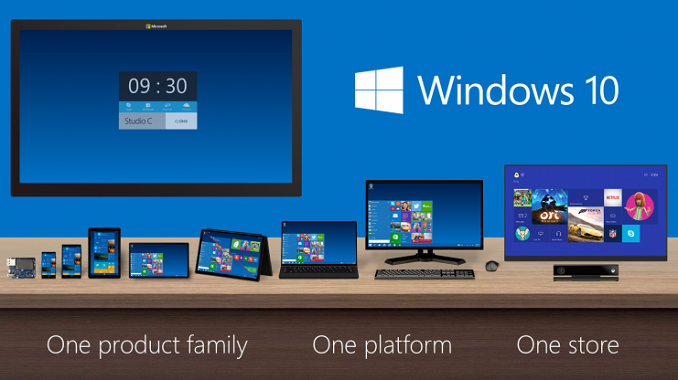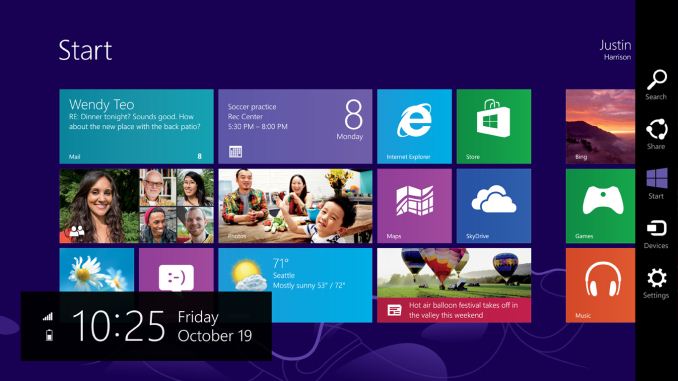Windows 10 Technical Preview First Impressions: The Return Of The Desktop
by Brett Howse on November 13, 2014 8:00 AM EST- Posted in
- Software
- Microsoft
- Windows 10

I’ve said this before, and I will reiterate it now. Windows 8, in general, is not perceived in a positive light. Not necessarily because of the lack of features, or even due to the touch first interface, but because from the start people did not buy into the paradigm. We can argue over why that was, and the specifics are likely different for every individual. But a big part of that was that Windows, which has had a familiar interface since Windows 95, had changed dramatically in look, feel, and general use. The traditional mouse and keyboard PC and notebook is a big part of the Windows user base, and especially at the beginning, Windows 8 did not cater to that crowd. While there were certainly improvements to the desktop, it was not enough to overcome the negative feelings of many users in regards to being productive on their PC. I say this as a fan of Windows 8.1, and I say this despite the positive review from this site. Windows 8 was an OS that worked, but had a steep learning curve that many people did not want to bother learning.
One of the biggest issues facing Windows 8 was just how much people liked Windows 7. Windows 7 was seen as the savior to Vista, and fixed many of its issues. But a lot of the initial problems with Vista were due to a major change in the driver model as well as the security model, which caused a lot of compatibility issues with older programs which expected administrator rights, as well as many hardware devices needed driver updates. With Windows 7, all of those changes were in the rear view mirror, allowing 7 to be a tweak of the overall UI and functionality rather than a rebuild of the OS from the ground up. With Windows 8, the move to touch first caused another dramatic upheaval. This time, rather than incompatible programs and hardware, we got a new Start Screen, a new runtime in WinRT, and a new app model with the Windows Store. For reasons that will never be made clear, the familiar start button was even removed, with the designers relying on hidden functions such as the hot corners to navigate around the OS with a mouse and keyboard. Luckily this change was reversed for Windows 8.1, with the start button returning, even if it still opened the Start Screen. With the Windows 8.1 Update, the system was made much more usable for a mouse and keyboard with the return of the menu bar to close apps, rather than dragging them down off the screen, and several other changes as well which brought the balance back somewhat to cover both touch interfaces as well as the mouse and keyboard.
 Windows 8 at launch in October 2012
Windows 8 at launch in October 2012
With Windows 8, Microsoft tried out an operating system which would work with a single interface across a breadth of hardware, from small form factor tablets, up to 30” monitor desktops. While they certainly succeeded in creating an interface that worked across all of those platforms, it was not ideally suited to any of them. With the tablet mode, the new Start Screen worked very well, and the charms menu and app switcher were fairly easy to use. But many of the settings and programs would be on the desktop, where touch only worked sparingly. Some desktop applications, such as Office, were created with a touch mode to increase the size of the onscreen elements, but overall the experience was subpar. Similarly, on the desktop, the touch interfaces were not ideal, and the hot corners certainly had issues especially on multi-monitor systems.
Windows 10 Technical Preview at launch
But now we come to Windows 10. Windows 10 is ditching the “One Interface to Rule them All” mentality, and moving to a more user friendly model of a single store across all platforms, and multiple interfaces to the same OS depending on the current usage model. We have not seen all of this in practice as of yet in the Technical Preview, but Microsoft has demonstrated their solution to this change in input mode with a feature they are calling Continuum.
The goal is that those that are on a keyboard and mouse based system will have the traditional start menu and desktop, with apps in windows, but if you are on a touch based device, or if you go on a 2-in-1 from keyboard to touch, the system will switch to the Windows 8 style start screen with full screen apps.
One of the keys to having this experience is an app model that allows a developer to target this different user interface paradigms. Microsoft’s solution to this is Universal Apps.











198 Comments
View All Comments
Hixbot - Friday, November 21, 2014 - link
It's nice to see the desktop back, honestly I have had no problem with Windows 8.1 with classic shells installed it's basically Windows 7 without aero.My biggest gripe is this push to a Windows store.
Pushing WinRT and Windows store on use makes me feel like MS is just herding us into a gift shop at the end of a lousy theme park. I don't want PC devs to use the Windows store, I don't want MS to scrape money of the top of the business. I don't want another software distribution model being shoved down my throat. I like windows over android and ios because it runs win32 code. I like that coding for PC has been typically wide open for the past 35 years or so.
Windows had a huge part in that. I've always preferred Windows over Linux simply for the enormous, almost endless supply of windows binaries of all types, especially games. MS is pushing me away, and I might just use Linux and never buy a Windows computer again. Honestly MS must really envy Apple and Google creating app stores that bring them revenue and market power. I don't want a store full of mostly crappy $1 apps for my PC. I like my PC the way it is, just improve things like UI, kernel, security, performance, features, etc etc but enough with the store. If I want software, I'll do it the old fashioned way and find it on the internet and buy it from the developers on their website, or find open-source and add free software from vibrant developer communities, or I'll even go back to buying 5.25 floppies just don't point me at another dang app store.
piasabird - Saturday, November 22, 2014 - link
People just want a desktop computer to work like a desktop computer. Microsoft does not get this simple statement. Their problem is they don't understand desktop customers. One size fits all is not a good fit.piasabird - Saturday, November 22, 2014 - link
Maybe Microsoft is purposely sabotaging computers to get people to replace them?piasabird - Saturday, November 22, 2014 - link
A few days ago my Vista computer would no longer log in. I tried using the built in administrator account to fix it but after logging in all of the updates were gone and I was back to IE 9. the stupid thing would not even recognize it had networking and the services were turned off. That was a waste of time. It all started when I went downstairs and my computer was stuck at the Login Screen similar to what it might do after updating from windows update.IBM650 - Sunday, November 23, 2014 - link
Speaking of upgrading an app I used to use Azul on my IPAD, I allowed it to upgrade. now I cannot play AC3 movies, oh we removed it since Adobe said we needed to pay for some code. I bought the app and now it is unusable,Aspire AV - Sunday, November 23, 2014 - link
really it looks like a descent thing, microsoft has tried to solve the interface issue quite well by combining the features of Win 7 and Win 8 to make it more user friendly for the desktop users,, it looks a new avatar of Win 8 which is much more sustainable for the Win 7 users to switch to a new Win OS. Thats what Windows is all about. hope it bangs in the market as the Win 7. looking forward to this thing.Ashwij - Monday, November 24, 2014 - link
I am using this now on my laptop and I must say I am pleasantly surprised ! I did like the Windows 8.1 a little bit (I am a Linux user on my PC for over 6 years now) and desired to rest the version. Although the website says its a developer preview and should not be used on your main PC, it is very stable. Considering this is not even Beta( Build 9841).The updates are relatively less (for my 8.1 PC i get close to 500Mb updates a week), just about 12 Mb so far in a week. No crashes.
Only issues observed - Very Old games (circa Unreal Tournament 1999) do not run even in backward compatibility mode with hardware rendering. And Google Dive sync does not work
Rockfella.Killswitch - Thursday, November 27, 2014 - link
I am using the technical preview since two weeks or so. Love it to the core. Using it with ATI R7 240 gpu, 4GB corsair DDR3 ram. No issues whatsoever. Butter smooth. No major issues with drivers either. XBMC Gotham and other players run just fine. Dual display set-up also running great! MS has a winner.Rockfella.Killswitch - Thursday, November 27, 2014 - link
Been using it since two weeks. MS has a winner. Love it to the core.Lerianis - Friday, November 28, 2014 - link
And people like myself will reiterate: Windows 8 is viewed in a positive light by the majority of non-techies who have tried it. I have installed it on all but ONE of my machines and if Microsoft included Windows Media Center in Windows 8 without having to get the Professional version, I would have switched that one over as well.